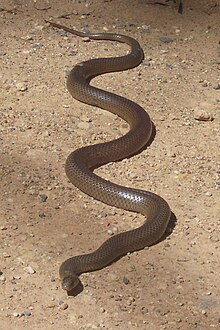Eastern brown snake
| Eastern Brown snake | |
|---|---|
 |
|
| Eastern brown snake, Tamban Forest near Kempsey, New South Wales | |
| Scientific classification | |
| Kingdom: | Animalia |
| Phylum: | Chordata |
| Subphylum: | Vertebrata |
| Class: | Reptilia |
| Order: | Squamata |
| Suborder: | Serpentes |
| Family: | Elapidae |
| Genus: | Pseudonaja |
| Species: | P. textilis |
| Binomial name | |
|
Pseudonaja textilis (A.M.C. Duméril, Bibron & A.H.A. Duméril, 1854) |
|
| Synonyms | |
The eastern brown snake (Pseudonaja textilis), often referred to as the common brown snake, is a species of venomous elapid snake of the genus Pseudonaja. This snake is considered the world's second most venomous land snake based on its LD50 value (SC) in mice. It is native to Australia, Papua New Guinea, and Indonesia.
Adult eastern brown snakes are highly variable in colour. Whilst usually a uniform shade of brown, they can have various patterns including speckles and bands, and range from a very pale fawn colour through to black, including orange, silver, yellow and grey. Juveniles can be banded and have a black head, with a lighter band behind, a black nape, and numerous red-brown spots on the belly.
This species has an average total length (including tail) of 1.1–1.8 m (3.6–5.9 ft). The maximum recorded size for the species is 2.4 m (7.9 ft), although any specimen of greater than 2 m (6.6 ft) in total length would be considered exceptionally large. Large eastern brown snakes are often confused with "king brown" snakes (Pseudechis australis), whose habitat they share in many areas.
They have 17 rows of dorsal scales at midbody, a divided anal scale, and 45–75 divided subcaudal scales.
The eastern brown snake is found all the way along the East coast of Australia, from the tip of Cape York, along the coasts and inland ranges of Queensland, New South Wales, Victoria and South Australia. They are also found in arid areas of the Northern Territory, the far east of the Kimberley in Western Australia, and discontinuously in parts of New Guinea, specifically northern Milne Bay Province and Central Province in Papua New Guinea, and the Merauke region of Papua Province, in the Indonesian part of New Guinea.
...
Wikipedia
